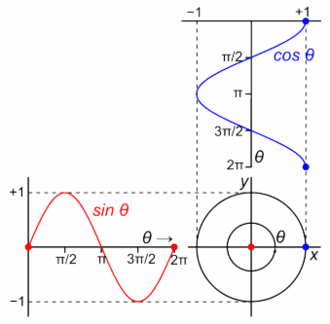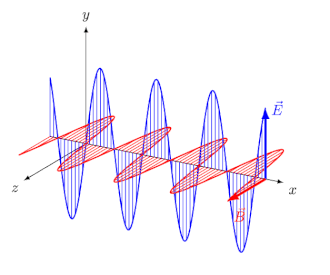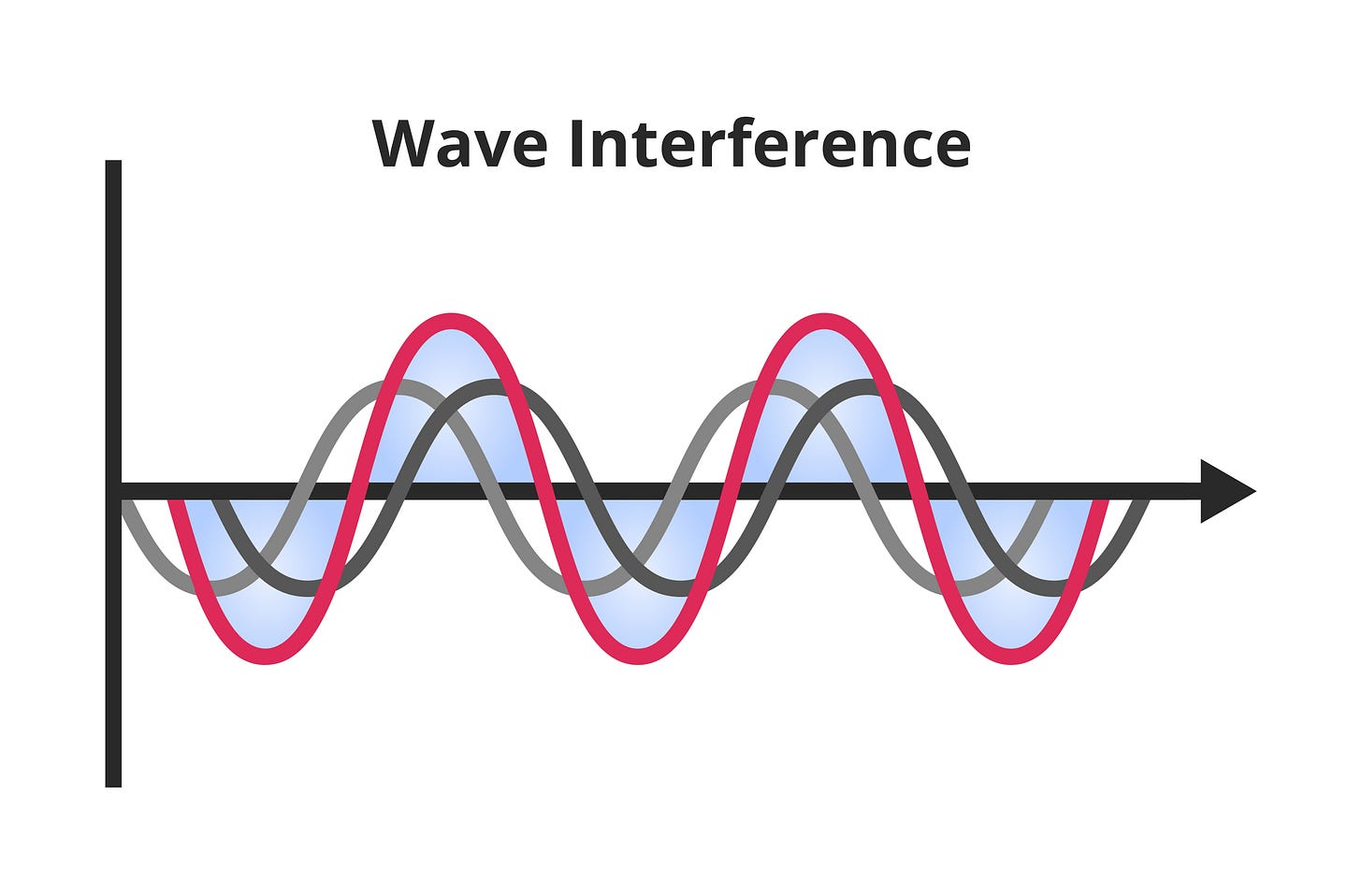The Mathematics of Talbot’s Holographic Universe
If you drop two stones in a still pond, the ripples don’t just pass each other neutrally. They meet. They interact. Where crest meets crest, the wave rises higher. Where crest meets trough, they cancel each other out. This is interference. It’s not an analogy. It’s the fundamental principle behind how waves behave—and if reality is really based on vibration and frequency, then this is we behave, too.
In the classic The Holographic Universe, Michael Talbot explores a striking possibility: that reality isn’t made of separate physical objects, but is instead a kind of holographic projection. Everything is interconnected. Each part of the whole contains the whole itself. But what Talbot leaves implicit—what becomes the missing key—is whose projection it is. If reality is holographic, who or what is producing the interference pattern?
The answer, drawn from Ontological Mathematics and the core ideas I’ve explored in The Dream of Matter, is this: it’s all of us. The universe is not a projection from a single mind, but an emergent field of interference—built from the mathematical frequencies of every participating mind. We aren’t passive observers. We are the source of the interfering waves. Each of us contributes to the total field, and it’s from that field that spacetime, matter, and form emerge.
Reality Is Waves, Not Things
The notion that everything is fundamentally wave-based isn’t poetic flourish—it’s mathematics. In contemporary physics, this shows up in quantum mechanics, where particles behave less like discrete things and more like probability waves—smears of potentiality that “collapse” upon observation. But Ontological Mathematics rejects this indeterministic view. It replaces chance with determinism, governed by hidden variables—souls with minds, exercising their free will.
Instead of randomness, we look to deterministic models—like pilot wave theory, where particles follow defined trajectories guided by an underlying wave. In that spirit, Ontological Mathematucs proposes that reality isn’t governed by statistical blur but by the precise interaction of infinite, eternal waves—generated by minds.
These waves show up in neuroscience as brain oscillations—delta, theta, alpha, beta, gamma—frequencies that structure cognition and experience. And in mathematics, we find the same architecture embedded in the two most powerful tools for understanding any wave-based system: Euler’s formula and the Fourier transform.
Let’s start with Euler:
Euler’s Formula: the motion of thought around a circle.
It’s deceptively simple, but its implications are staggering. At its core, it shows that circular motion—like a point rotating around a unit circle, or the perpetual motion of an eternal mind—necessarily produces sine and cosine waves. One represents motion on the x-axis (cosine), the other on the y-axis (sine). These are orthogonal—at right angles to each other. This isn’t just mathematical elegance; it’s the blueprint of light itself.
An Eternal Mind is Light
According to Ontological Mathematics, each soul—or monad—is an eternal mind, existing in a singularity outside of space and time. Its defining trait is eternal motion. But it doesn’t move randomly. It follows deterministic, cyclical paths described by Euler’s formula. And since sine and cosine waves are inherently orthogonal, an eternal mind is always producing pairs of perpendicular waves—exactly like light.
In physics, light is an electromagnetic wave: it consists of an electric field oscillating in one direction and a magnetic field oscillating in a direction perpendicular to it. These fields propagate together, self-sustaining, moving at the speed of light through the vacuum.
The monad’s eternal internal motion is structurally identical: a perfect, orthogonal interplay of waves—one real, one imaginary, forming a loop. In this way, the soul itself is light, not metaphorically, but mathematically.
Electromagnetic radiation: orthogonal electric and magnetic fields propagating through space. The wave produced by a fully coherent mind has this same orthogonality.
And just like with electromagnetic radiation, there is no reason—no sufficient reason—for the mind to produce just one wave. The Principle of Sufficient Reason demands maximality in the absence of a constraint. So the soul expresses all possible frequencies—an infinite spectrum of sine and cosine waves. This full-spectrum expression is the baseline condition of mind.
It’s not just two dimensions, either—this mental motion unfolds over six dimensions. Three real, three imaginary. For the sake of visualization, however, we’ll stick to two dimensions here.
What gives rise to structure, then, is not the presence of waves—but the organization of them.
Through its will, the monad selects, amplifies, and phase-aligns its internal components. That’s how it generates a signal—and that’s how the hologram of reality begins to form.
Interference: where order becomes chaos through phase difference.
In this view, the mission of the soul—the very goal of existence—is to reassemble itself as light. Not by eliminating difference, but by resolving phase contradiction. The soul is not trying to return to sameness. It’s trying to restore coherence—a state in which every wave supports, rather than opposes, the others.
But here’s the challenge: it’s not enough for the mind to solve for itself alone. Because every soul contributes to the total interference field, our coherence must also support the coherence of others. The soul’s final structure is not one of isolation, but of relational resonance. You must become a frequency that helps others become themselves.
It’s not about morality. It’s just mathematics.
Syntax and Semantics of Thought
At its most basic level, a mind is a waveform generator. Its onlymedium is frequency. But frequency by itself is not enough to carry meaning. For that, we need structure. And structure arises from the interplay of three elements:
Frequency: the base vibration—the rate of oscillation.
Amplitude: the strength or intensity of the signal.
Phase: the timing or alignment of the wave relative to others.
Together, these form the syntax of thought: the rules for how information is structured and transmitted. Syntax is formal. It’s the architecture of signal. But structure without meaning is noise.
That’s where semantics comes in.
Semantics is what makes a signal mean something. It’s how phase-aligned patterns acquire internal logic, reference, and emotional significance. Thought isn’t just a waveform—it’s a modulated waveform, shaped to carry a particular resonance. And that modulation happens through phase.
A thought isn’t “created” in a classical sense. It’s selected—drawn from the infinite internal potential of the soul’s base waveforms and made manifest by shifting phase relationships. That’s it. That’s really the core function of the mind:
To modulate phase.
Every act of attention, reflection, or choice is a modulation. Every insight is a re-alignment. Every contradiction is a phase clash. The whole story of a soul’s evolution is the story of its waveform becoming more internally coherent—until its signal loops cleanly, fully, radiantly.
And when that happens, the soul doesn’t become something new.
It becomes what it always was.
How One Mind Becomes Many
When a soul first enters into becoming—when its eternal, coherent light falls into phase disarray—it doesn’t emerge as a neatly structured self. It emerges as noise. A field of infinite waveforms, maximally entropic, spinning in and out of coherence. There’s no identity yet. No center. No narrative. Just a raw signal soup, filled with possibility but devoid of order.
But even in that chaos, patterns begin to form.
Just as interference patterns naturally emerge when waves interact, sub-patterns emerge within the mind. These are regions of partial coherence—pockets where a few frequencies stabilize, align, and begin to loop. These early stabilities become the seeds of proto-selves—not full identities, but recurring tendencies, feelings, and thoughts that start to reinforce themselves through repetition.
This is the ontological root of what we call the self: not a fixed entity, but a resonant pattern. A coherence zone. And just like harmonics on a string, multiple coherence zones can form at once. This means a single mind doesn’t evolve linearly from disorder into unity. It fragments first—into partial selves, impulses, archetypes, coping strategies, internal voices—and then slowly works toward integrating them.
In The Dream of Matter, I describe this as the ontological self: not a psychological abstraction, but a mathematically emergent interference pattern. The self is the sum of its sub-patterns—some coherent, some contradictory, each representing a region of the soul’s signal with its own frequency and phase structure.
This helps explain phenomena like Dissociative Identity Disorder (DID), not as pathologies in the traditional sense, but as extreme cases of natural signal fragmentation. When internal sub-patterns become so phase-incoherent that they can no longer share information, they function as separate minds. The result is not one unified self, but a plurality of selves—each with its own coherence pocket, unaware of the others.
But the truth is, we all function this way to some degree.
Every mind is plural at first. Every identity is a composite structure, built from semi-stable waveforms, organized through memory, experience, and will. The journey toward integration is not the suppression of parts—it’s the alignment of phases. To become whole is to bring these sub-patterns into resonance. To become internally synchronous.
So the soul’s evolution is not from singularity to complexity.
It’s from chaotic complexity to structured unity.
It begins with the many, and moves toward the one.
The Mathematical Hologram
What we call “the external world” is not a physical container we inhabit. It’s the interference pattern of minds—a mathematically generated domain that emerges from the overlapping frequencies of all monads participating in reality.
In Ontological Mathematics, each soul is a self-contained singularity of eternal motion. Inside, it cycles through infinite sine and cosine waves, modulated by amplitude and phase. Alone, this waveform remains private—a dreamscape projected inward.
But souls don’t remain isolated. When minds begin to interact—when their waveforms intersect—they produce an interference field. This field is not metaphorical. It is literal, mathematical, and projected outward as what we perceive as spacetime and matter.
Each mind’s internal signal contributes to a greater signal field, and through a generalized Fourier transform, this collective interference is rendered in six dimensions: the three of space, and three corresponding dimensions of time. The rendering is not arbitrary. It is the mathematical recomposition of all participating signals, as seen from within the frequency domain.
This is where the holographic model becomes more than an analogy.
A hologram is generated by interfering coherent light waves—each carrying phase information—onto a surface. What’s encoded is not the image itself, but the relational structure of waves. And that’s exactly what minds do: they don’t transmit objects, they transmit relational information, encoded in frequency and phase.
Each mind doesn’t literally contain the entire universe, but it reflects it—through the phase relationships it holds with every other mind. Your monad is a singularity, but its internal structure mirrors the full interference field. Like a hologram, where each fragment contains the whole in miniature, your mind encodes a compressed reflection of reality. You are not the whole—but you are shaped by it, and structurally identical to it.
So the world is a mathematical hologram, generated not from a single source, but from every mind contributing its signal. You don’t live in the world. You build it. Alongside everyone else.
And what about time?
Time is not a force or a flow. It’s a dimensional coordinate that tracks change in phase relationships. What we experience as the “arrow of time” is simply the evolution of wave alignment—the reordering of the signal field. From your vantage point as a mind in motion, this feels like time passing. But it’s not a universal current. It’s the internal sequencing of your own transformations as you “move” through the interference field.
Becoming a Clearer Self
All of this matters because we are not passive nodes in this field. We are all signal sources. We project, receive, and modulate waves constantly—whether or not we’re aware of it. And our ontological self—the real “us” beneath all the narratives—is a frequency structure that can become more or less coherent.
The work of growth is about resolving interference, and becoming mathematically integrated and coherent. When we align your internal frequencies—when our values, intuitions, and thoughts are structurally harmonious—we become a stable source of resonance. We clarify our signal. And in doing so, we contribute differently to the whole. We shift the field.
The world is not changed by force. It’s changed by coherence. The more self-aware, internally resonant minds exist, the more constructive interference we generate across the collective. The more harmonics emerge. The clearer the hologram becomes.
The Universe as a Mirror of Minds
So yes, the universe may be a kind of hologram—but it’s not a simulation. It’s a composition. A grand mental symphony, shaped moment by moment by the interference of souls. Some minds play noise. Some strike true chords. But all of us are part of the pattern.
Talbot glimpsed it. Bohm theorized it. Ontological mathematics defines it precisely.
The world isn’t imposed from outside or rendered by some external engine. It emerges from within—a structured field built from the phase relationships between minds. Each soul contributes to that field, not by thinking or believing in a mystical sense, but through the mathematical structure of (modulating) its own waveform.
And one day, when enough of those waveforms come back into alignment—individually and collectively—the interference pattern will simplify. The distortion will resolve. And the hologram will return to what it always was beneath the noise:
Light.







